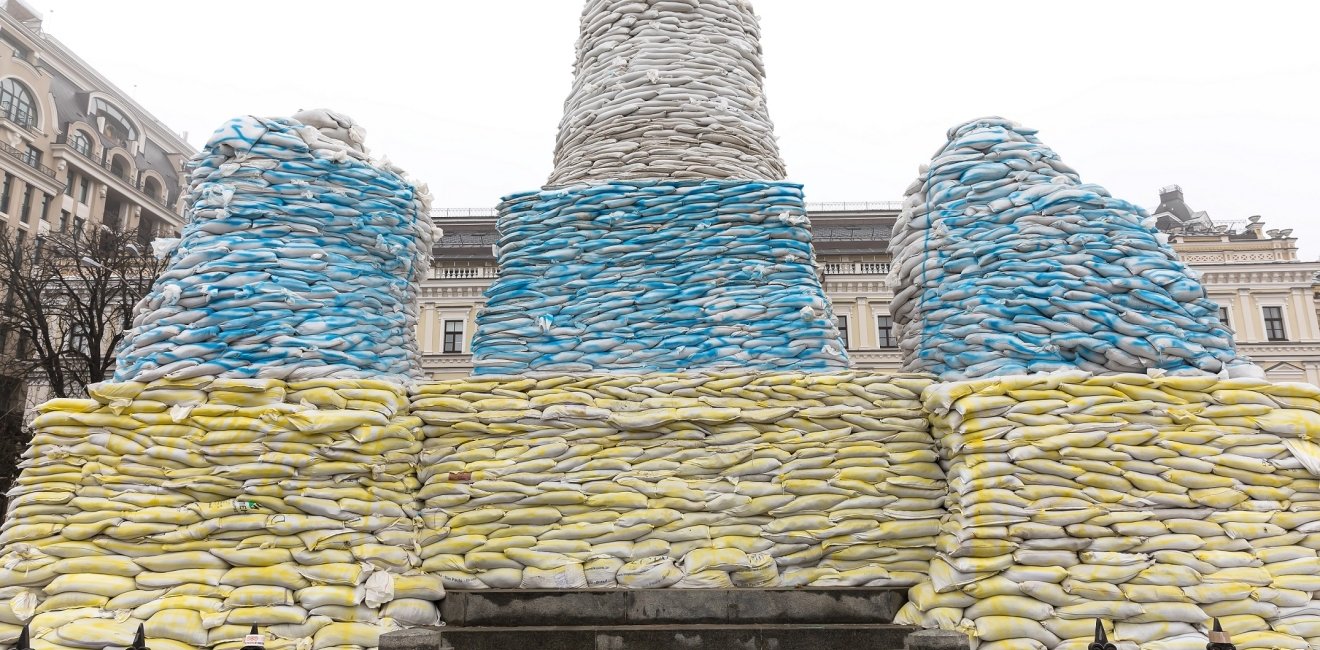
A blog of the Kennan Institute
BY BLAIR A. RUBLE
As the battles for Bucha and Irpin raged just outside town, well-known Ukrainian street artist Sasha Korban turned a bleak Kyiv wall into a powerful statement proclaiming the enduring presence of an independent Ukraine. Korban painted a moving street mural depicting two gaunt hands gently sewing together a tattered Ukrainian flag.
Korban presented his wall painting on the internet with an appeal to the international community for support of his war-ravaged country. “Ukraine. War. The 40th day,” Korban wrote. “I’m speechless. So many people died. So many innocent kids been killed. So many souls been crippled. Thanks to the incredible efforts of our soldiers, army, volunteers and all the Ukrainians who have united, we are holding back the enemy so that he cannot tear apart our homeland.” Korban’s powerful statement in words and in paint shouts the deep determination of Ukrainians who are refusing to back down in the face of Russia’s war machine.
Now in his thirties, Korban achieved international recognition for his potent street art long ago. A native of Kirovske in Ukraine’s now-contested Donbas region, Korban worked as a miner before turning to painting. He began at the start of this century, as many street artists do, painting graffiti. He became particularly fond of creating portraits with spray paints on canvas. He developed his aesthetic sensibility by borrowing techniques from various styles and modalities to produce a distinctive personal style.
Painting on walls might seem an especially frivolous endeavor at a time of fierce war; it also is a dangerous one. Artists such as Korban face Russian bombardments, sirens, curfews, very limited public transportation, and a lack of materials. Some have joined the fight with the Ukrainian army, others have volunteered for Territorial Defense units in Kyiv and in other cities. Nonetheless, street art has been thoroughly integrated with political activism throughout Ukraine for some time.
Artists claimed the Ukrainian capital’s streets for pro-Western supporters during the 2013–2014 Revolution of Dignity. Looking forward, we can anticipate that street art similarly will reclaim streets for Ukraine. Muralists created a vibrant energy throughout the city’s public spaces at that time. Their paintings proclaimed the beliefs, identities, and political positions animating the demonstrations of the era. As in the past, the arts became a substitute for politics in a nation that was denied a state for too long. Artists turned to several artistic mediums—poster art, photography, sculpture, painting, art associations, cinema, music—to proclaim their, and their compatriots’, presence. Their creations inspired activists and everyday citizens to see the uprising through to a successful conclusion.
Street art flowered in Kyiv and other cities following 2014. The Kyivmural.com website has chronicled more than 170 artworks by thirty-five artists spread across the capital on the eve of the Russian invasion. Often gigantic, some murals highlight local identities, others fables and fairytales. Paintings honor heroes, such as Armenian-Ukrainian activist Serhiy Nihoyan, who was the first person killed in the 2014 Hrushevskoho riots; and present allegories of contemporary Ukrainian politics, such as a Ukrainian St. George slaying a double-headed dragon representing Russia. Painted by Ukrainian and international artists alike, these works brighten an at times dreary post-Soviet cityscape. Residents take their local mural to heart, identifying more powerfully with their neighborhoods, city, and nation.
The street art produced in response to the Revolution of Dignity reflected the compelling creative artistic diversity that was emerging in Kyiv. It forever imprinted the heart-rending memories of the harsh 2013-2014 winter of rebellion. Korban’s latest masterpiece both preserves the sorrow of a city and country plundered by a ruthless invader and proclaims a resilience of spirit that promises to hold Ukraine together. As so often has been the case in Ukrainian history, art preserves the tragedy of this moment while revealing a path forward.
The opinions expressed in this article are those solely of the authors and do not reflect the views of the Kennan Institute.
Author

Former Wilson Center Vice President for Programs (2014-2017); Director of the Comparative Urban Studies Program/Urban Sustainability Laboratory (1992-2017); Director of the Kennan Institute for Advanced Russian Studies (1989-2012) and Director of the Program on Global Sustainability and Resilience (2012-2014)

Kennan Institute
After more than 50 years as a vital part of the Wilson Center legacy, the Kennan Institute has become an independent think tank. You can find the current website for the Kennan Institute at kennaninstitute.org. Please look for future announcements about partnership activities between the Wilson Center and the Kennan Institute at Wilson Center Press Room. The Kennan Institute is the premier US center for advanced research on Eurasia and the oldest and largest regional program at the Woodrow Wilson International Center for Scholars. The Kennan Institute is committed to improving American understanding of Russia, Ukraine, Central Asia, the South Caucasus, and the surrounding region through research and exchange. Read more

Explore More in Focus Ukraine
Browse Focus Ukraine
Talking to the Dead to Heal the Living

Ukrainian Issue in Polish Elections


